If you’ve struggled to keep indoor plants alive, don’t let past failures deter you from trying again. You’ll find that certain flowering plants are surprisingly resilient, thriving for years with minimal care while providing endless blooms. From the low-maintenance Peace Lily to the show-stopping Purple Angel Wing Orchid, these 15 flowering plants can transform your living space into a year-round garden – and you won’t believe how easy some of them are to maintain.
Contents
1. Peace Lily
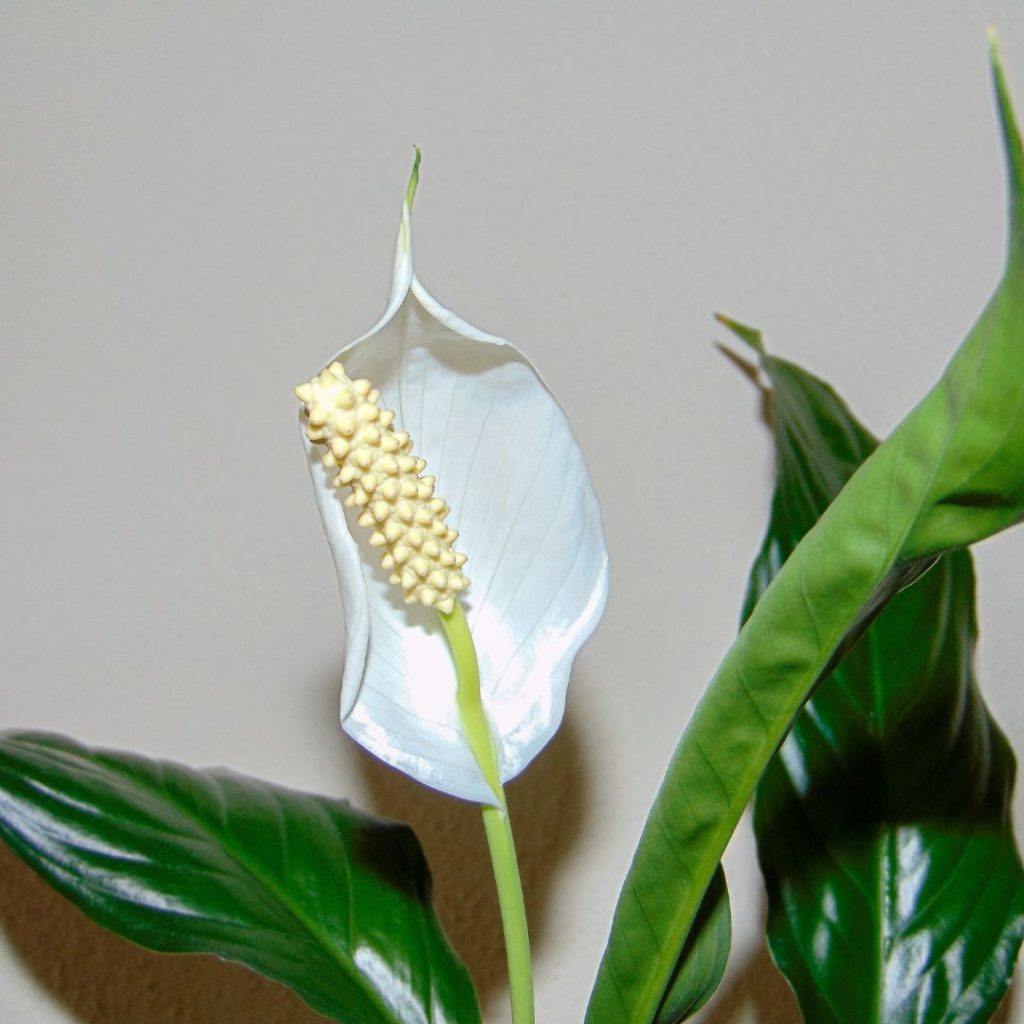
The Peace Lily (Spathiphyllum) is a popular tropical houseplant known for its elegant white flowers and glossy dark green leaves. This low-maintenance plant not only adds beauty to indoor spaces but also helps purify the air by removing common household toxins. The distinctive white “flower” is actually a modified leaf called a spathe, which surrounds the true flowers on the spadix. Peace lilies typically bloom several times a year, with each bloom lasting several weeks.
- Light: Bright indirect light; can tolerate low light but may not flower as frequently; avoid direct sunlight
- Water: Keep soil consistently moist but not waterlogged; water when top inch of soil feels dry
- Soil: Well-draining potting mix rich in organic matter
- Humidity: Prefers high humidity; mist leaves regularly or use a humidity tray
- Temperature: 65-80°F (18-27°C); protect from cold drafts
- Fertilizer: Feed with balanced liquid fertilizer every 6-8 weeks during growing season
- Pot: Use container with drainage holes
- Soil pH: 5.5-6.5
2. Christmas Cactus
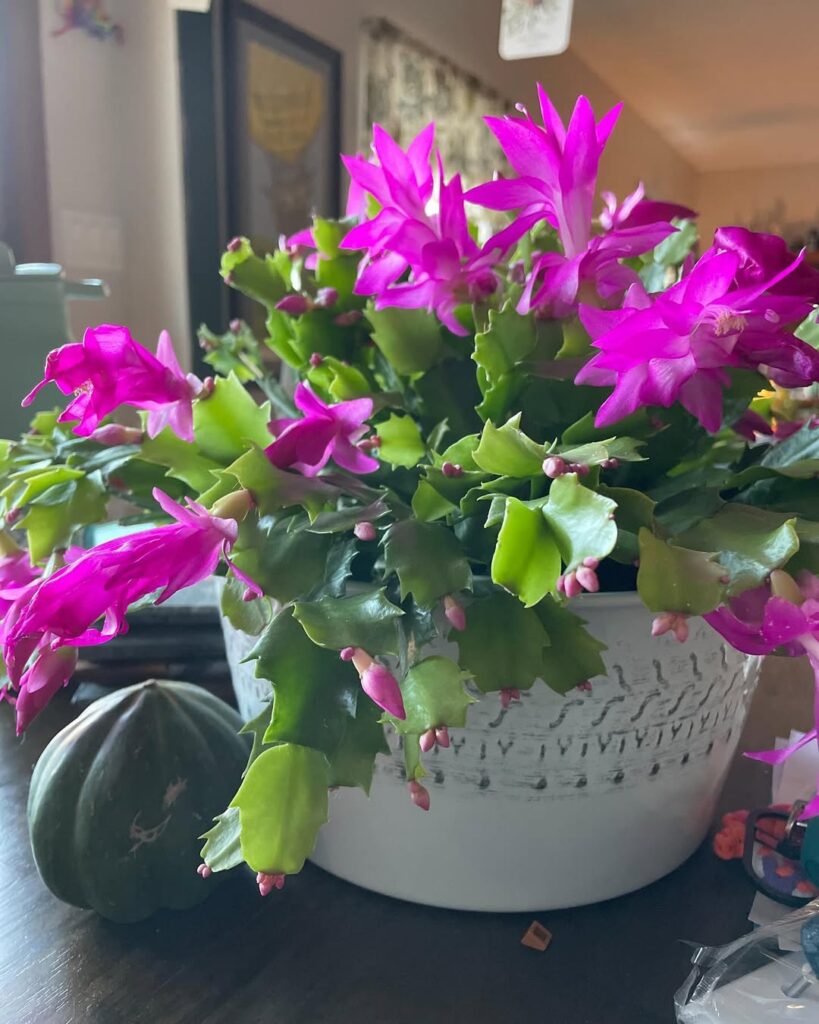
The Christmas Cactus (Schlumbergera) is a popular flowering houseplant known for its vibrant blooms that appear during the holiday season. Native to Brazilian rainforests, this epiphytic succulent features flattened, segmented stems that cascade downward and produce tubular flowers in shades of pink, red, white, or purple. Unlike desert cacti, the Christmas Cactus is a tropical plant that can bloom repeatedly for many years when properly cared for, making it an excellent long-term indoor companion.
- Light: Bright, indirect sunlight; avoid direct sun which can burn leaves; needs 12-14 hours of darkness daily during fall to initiate blooming
- Water: Keep soil consistently moist but not waterlogged; reduce watering during fall to encourage blooming; water when top inch of soil feels dry
- Soil: Well-draining potting mix rich in organic matter; mix regular potting soil with orchid mix or perlite
- Humidity: Prefers 50-60% humidity; benefits from occasional misting
- Temperature: 65-75°F (18-24°C) during day; slightly cooler at night
- Fertilizer: Feed monthly with balanced houseplant fertilizer during growing season; stop feeding during blooming period
- Pot: Use containers with drainage holes; prefers to be slightly root-bound
3. African Violet
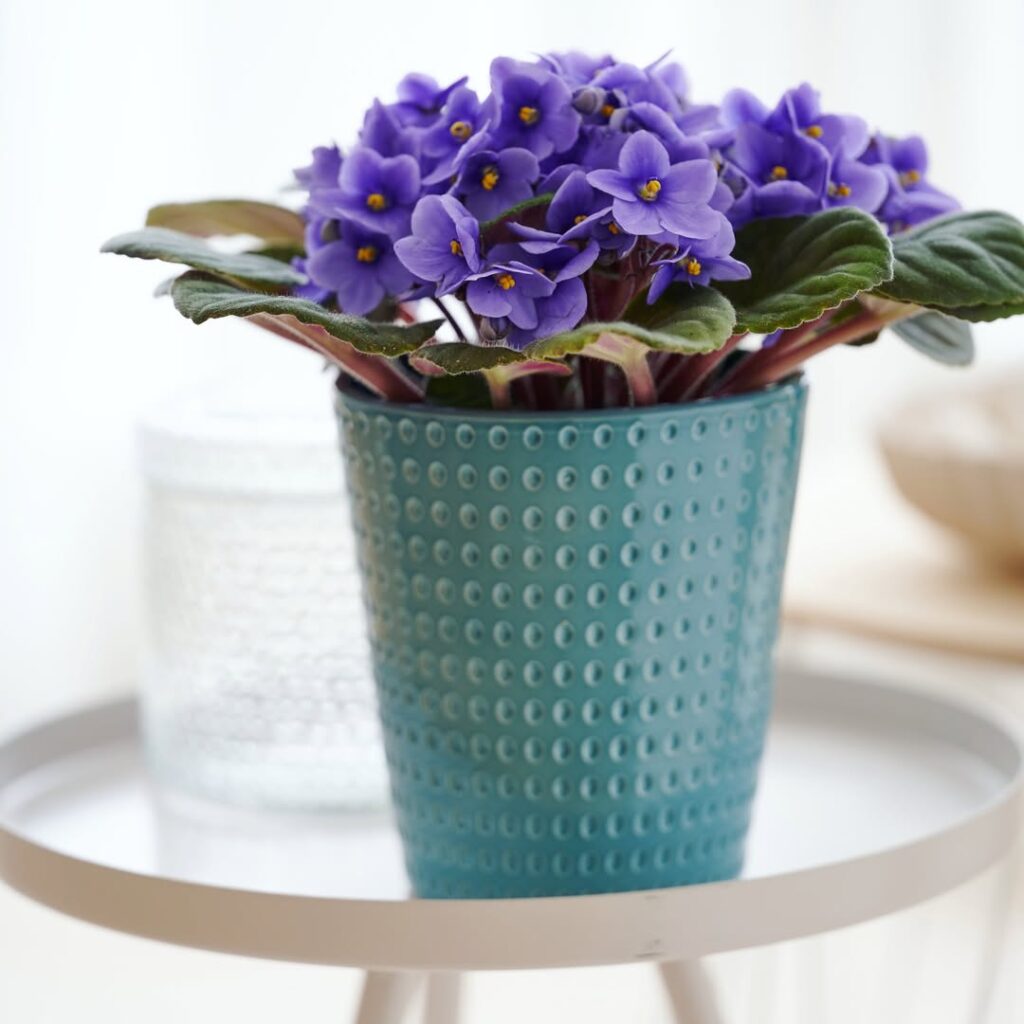
African Violets are charming, compact houseplants known for their delicate clusters of purple, pink, white, or blue flowers set against fuzzy, dark green leaves. These popular indoor plants, native to East Africa, bloom multiple times throughout the year when properly cared for and can live for several decades, making them excellent long-term companion plants for home gardeners.
- Light: Bright, indirect light; avoid direct sunlight; 4-6 hours of filtered light daily; east or north-facing windows are ideal
- Water: Keep soil consistently moist but not waterlogged; water from bottom when top inch feels dry; avoid getting water on leaves to prevent spotting
- Soil: Light, well-draining African violet potting mix; rich in organic matter; slightly acidic pH (6.0-6.5)
- Temperature: 65-75°F (18-24°C); protect from cold drafts
- Humidity: 40-60%; use humidity trays or place near other plants
- Fertilizer: Feed every 4-6 weeks with balanced, water-soluble fertilizer specifically for African violets
- Container: Small pots with drainage holes; prefer to be slightly root-bound
4. Flamingo Flower
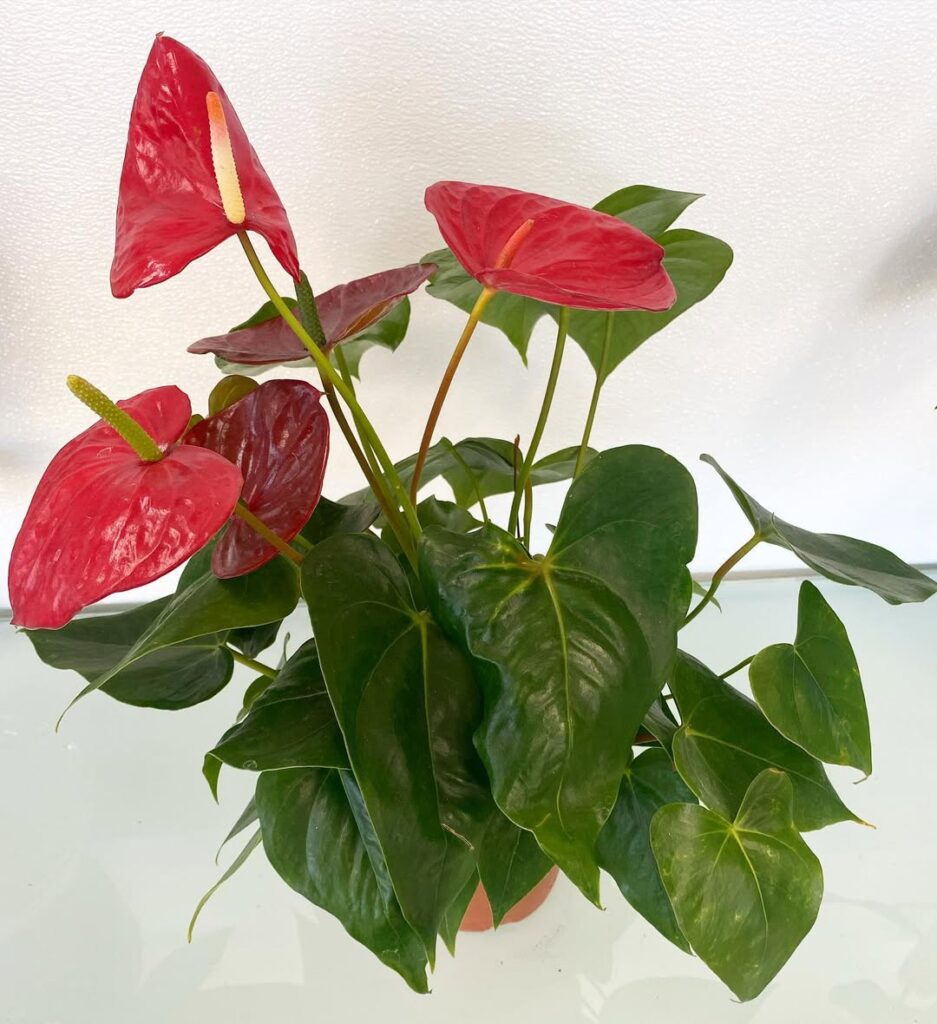
The Flamingo Flower (Anthurium) is a stunning tropical plant known for its glossy, heart-shaped leaves and vibrant, long-lasting blooms that come in shades of red, pink, white, and coral. The actual flower is a tiny spike, called a spadix, surrounded by a waxy, modified leaf called a spathe, which gives the plant its distinctive appearance. This exotic houseplant is prized for its air-purifying qualities and can bloom throughout the year when properly cared for.
- Light: Bright, indirect sunlight; avoid direct sun which can scorch leaves
- Water: Keep soil consistently moist but not waterlogged; water when top inch of soil feels dry
- Humidity: High humidity (60-80%); regular misting or use of humidity tray recommended
- Temperature: Warm conditions between 65-80°F (18-27°C)
- Soil: Well-draining, loose potting mix rich in organic matter
- Fertilizer: Feed monthly during growing season with balanced, phosphorus-rich fertilizer
- Potting: Repot every 2-3 years in spring; prefers to be slightly root-bound
- Toxicity: All parts are toxic if ingested; keep away from pets and children
5. Amaryllis Bulb
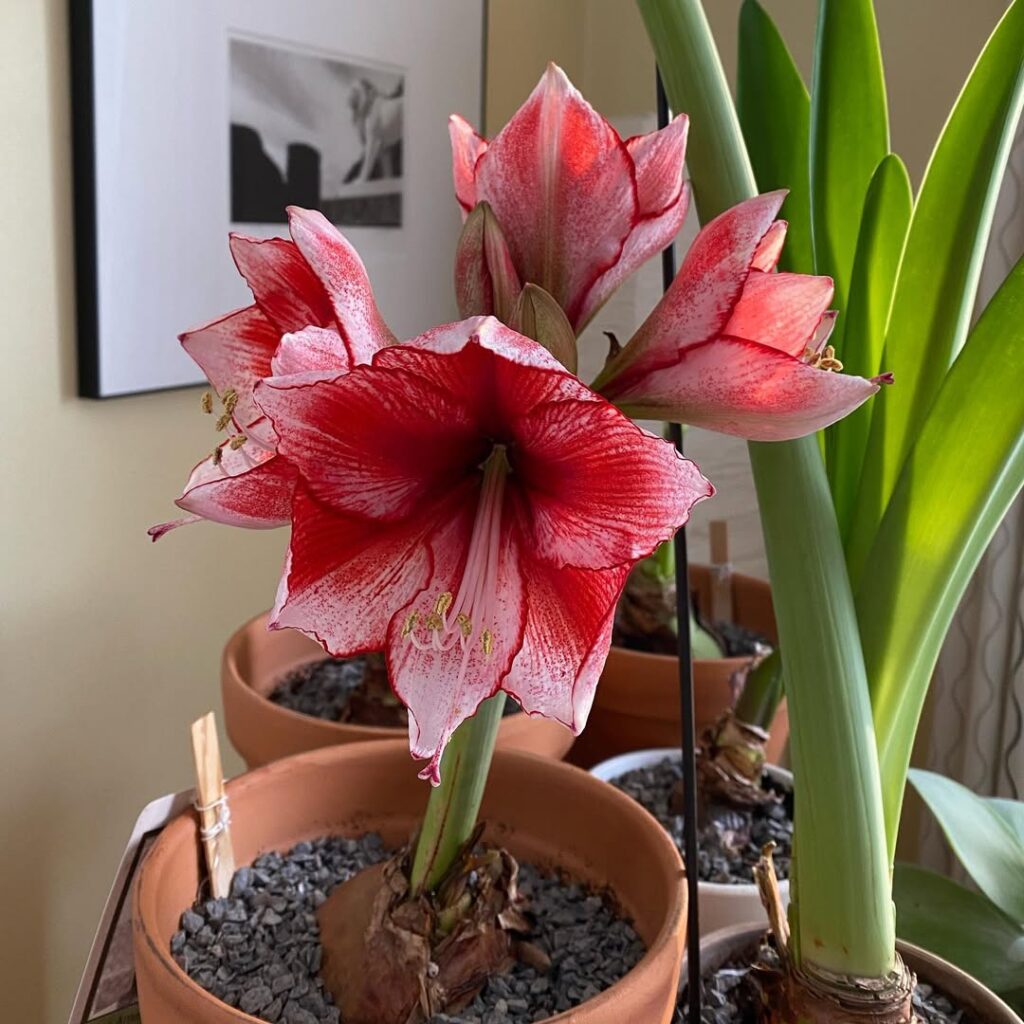
The Amaryllis bulb produces large, showy flowers in vibrant shades of red, pink, white, and salmon. This popular indoor plant blooms during winter months, typically producing 2-3 flower stalks with 4-6 trumpet-shaped blooms per stalk. The bulb can be forced to bloom indoors and, with proper care, will rebloom annually for many years, making it both a striking decoration and a long-lasting investment for indoor gardeners.
- Light: Bright, indirect sunlight; direct sun only during winter months
- Water: Keep soil moist but not waterlogged during growing season; reduce watering when dormant
- Soil: Well-draining potting mix rich in organic matter
- Temperature: 70-75°F (21-24°C) during growing season; 55°F (13°C) during dormancy
- Humidity: Average room humidity is adequate
- Fertilizer: Monthly feeding with balanced fertilizer during growing season
- Container: Pot should be only slightly larger than the bulb, with good drainage
- Planting depth: Plant with top 1/3 of bulb exposed above soil
6. Begonia Semperflorens
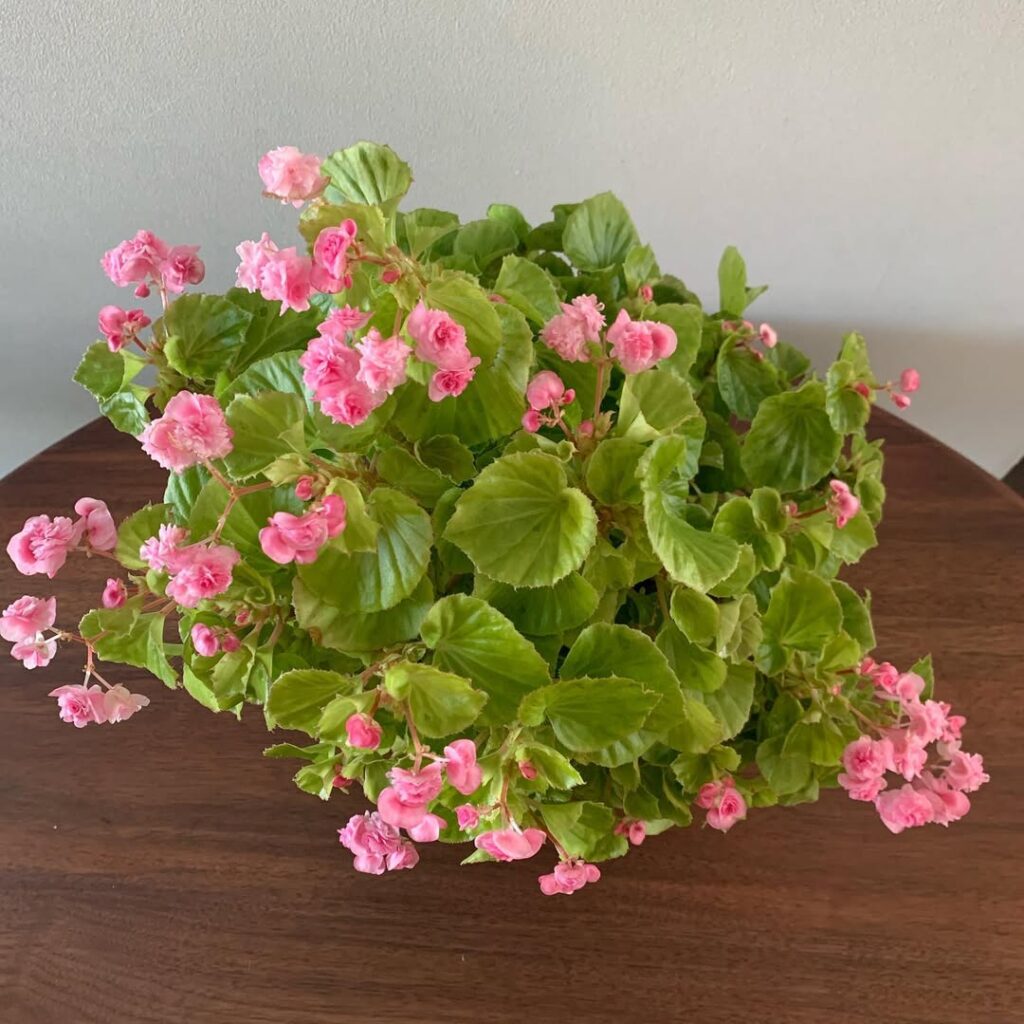
Begonia Semperflorens, also known as Wax Begonia, is a compact, evergreen perennial that produces clusters of delicate flowers in shades of pink, red, or white against glossy, rounded foliage. These reliable bloomers flower continuously throughout the year when grown indoors, making them popular houseplants. The plants typically reach heights of 6-12 inches, forming neat mounds that work well in containers or as border plants when moved outdoors during warm months.
- Light: Bright, indirect light; can tolerate partial shade but needs some sun for best flowering; protect from intense afternoon sun
- Water: Keep soil consistently moist but not waterlogged; water when top inch of soil feels dry
- Soil: Well-draining, rich potting mix with high organic content
- Temperature: 60-75°F (15-24°C); protect from cold drafts
- Humidity: Moderate to high; benefits from regular misting
- Fertilizer: Feed monthly during growing season with balanced, water-soluble fertilizer
- Pruning: Remove spent blooms and yellowing leaves to encourage continuous flowering
8. Kalanchoe Succulent
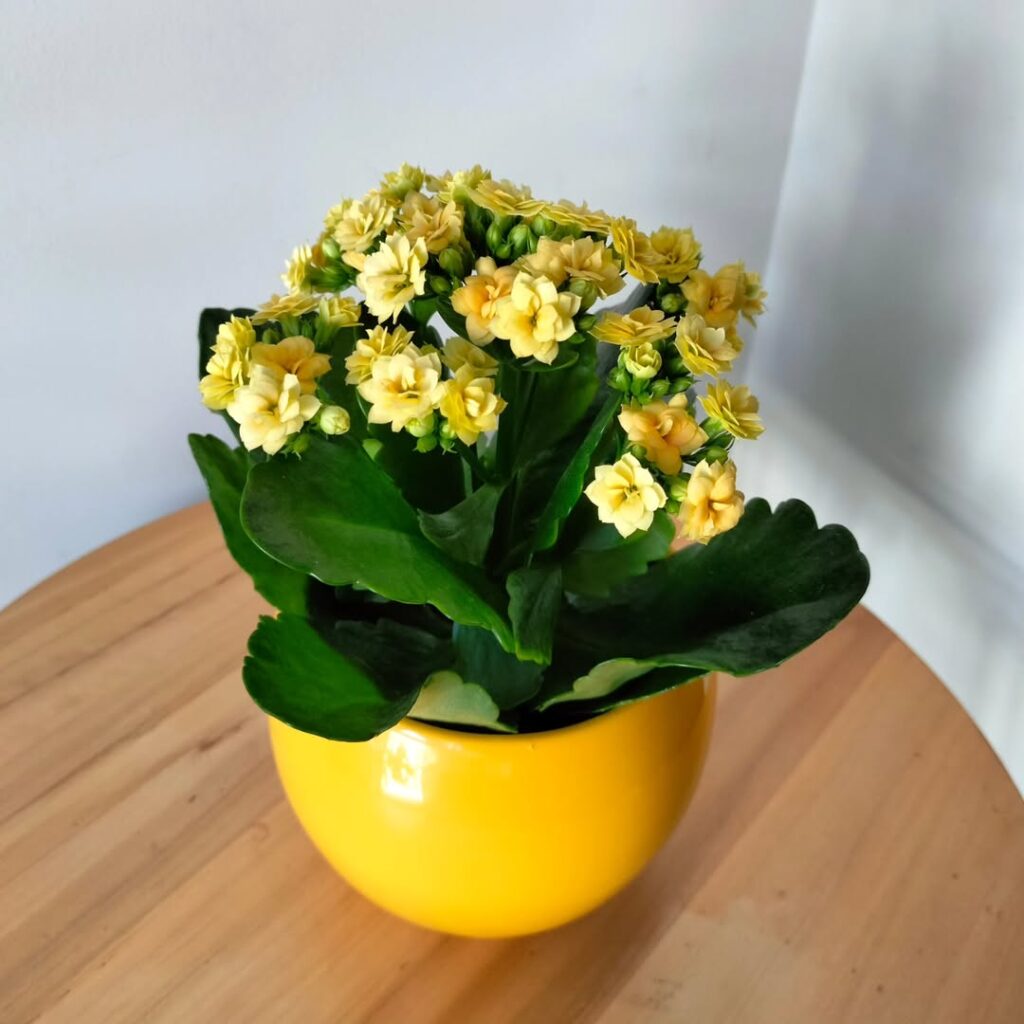
The Kalanchoe succulent is a popular flowering houseplant known for its clusters of small, vibrant blooms in shades of pink, red, orange, yellow, and white. Native to Madagascar, this compact plant features thick, scalloped leaves and can bloom for several weeks, typically during winter and early spring. With proper care, Kalanchoe can rebloom multiple times, making it an excellent long-lasting indoor plant choice.
- Light: Bright, indirect sunlight; some direct morning sun is beneficial; protect from harsh afternoon sun
- Water: Allow soil to dry between waterings; water sparingly in winter; avoid overwatering
- Soil: Well-draining potting mix specifically for succulents and cacti
- Temperature: 60-85°F (15-29°C); can tolerate brief periods outside this range
- Humidity: Tolerates low humidity; no special humidity requirements
- Fertilizer: Feed with balanced fertilizer every 2-3 months during growing season
- Pot: Container with drainage holes to prevent root rot
- Pruning: Remove spent flower heads and any yellowed leaves
9. Snake Plant
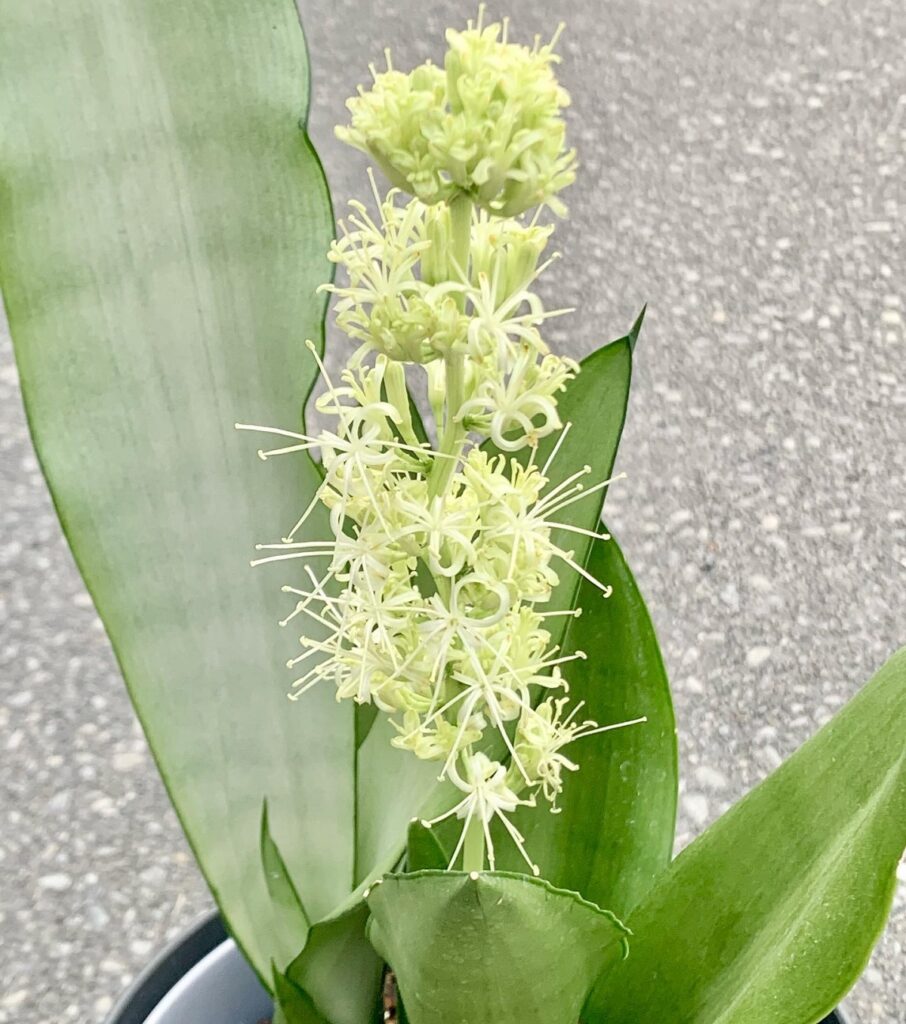
The Snake Plant, while primarily grown for its striking architectural foliage, can produce fragrant flower spikes under ideal conditions. These flowers appear as delicate, cream-colored or greenish-white clusters on long stalks, emerging from the center of the plant’s rosette. Though flowering is relatively rare in indoor settings, mature and well-cared-for plants may reward owners with blooms that emit a sweet, honey-like fragrance, particularly in the evening hours.
- Light: Tolerates low light but thrives in bright, indirect light; can handle some direct morning sun
- Water: Allow soil to dry completely between waterings; water less in winter
- Soil: Well-draining potting mix; preferably succulent or cactus soil
- Humidity: Adaptable to various humidity levels; tolerates dry air
- Temperature: 65-85°F (18-29°C); can survive brief periods outside this range
- Fertilizer: Light feeding during growing season with balanced fertilizer
- Container: Pot with drainage holes; slightly root-bound conditions encourage blooming
- Soil pH: 6.0-7.5
10. Pink Jasmine
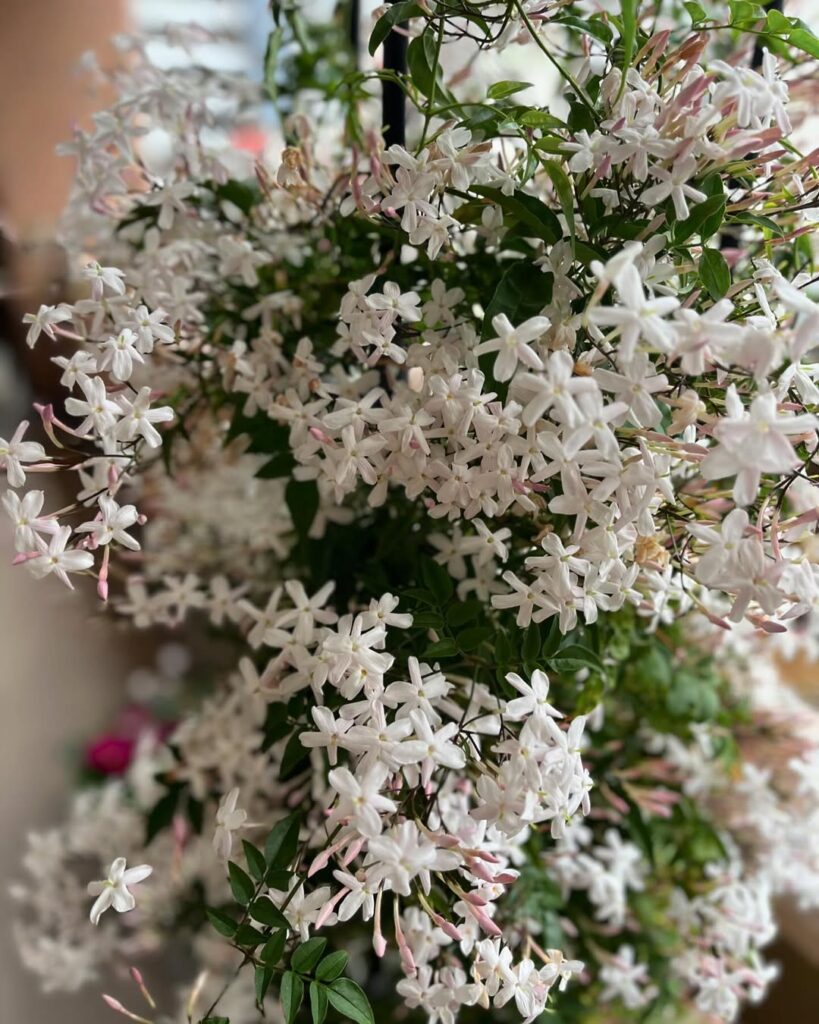
Pink Jasmine (Jasminum polyanthum) is a fragrant, evergreen vine that makes an excellent indoor plant, producing clusters of delicate pink buds that open into white, star-shaped flowers. This climbing plant blooms profusely during late winter to early spring, filling rooms with its sweet perfume. While naturally a climbing vine, it can be trained as a houseplant when provided with appropriate support like trellises or hanging baskets.
- Light: Bright, indirect sunlight; can tolerate some direct morning sun
- Water: Keep soil consistently moist but not waterlogged; water when top inch of soil feels dry
- Soil: Well-draining, rich potting mix with added organic matter
- Temperature: 60-75°F (15-24°C)
- Humidity: Moderate to high; benefits from regular misting
- Fertilizer: Feed monthly during growing season with balanced fertilizer
- Pruning: Trim after flowering to maintain shape and encourage bushiness
- Support: Requires climbing support such as trellises or stakes
11. Crown of Thorns
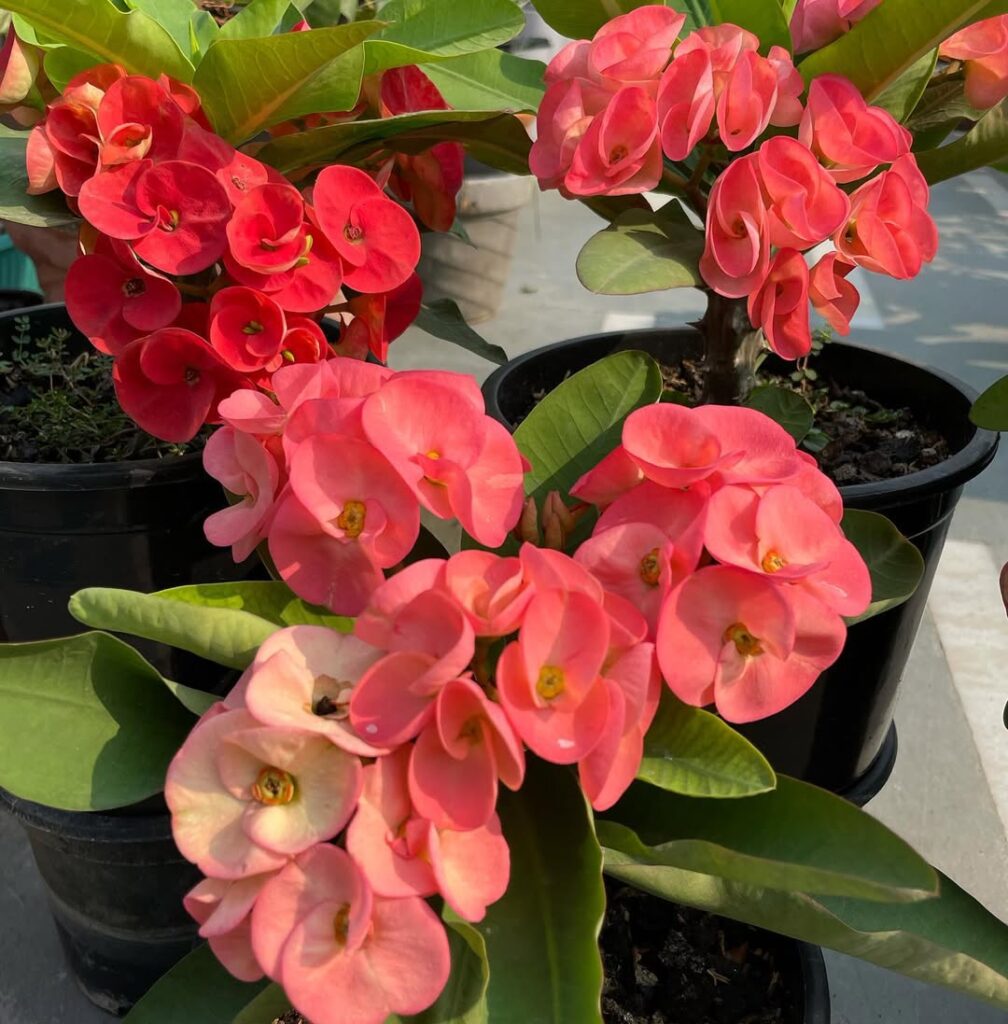
Crown of Thorns (Euphorbia milii) is a sturdy succulent houseplant known for its thick, spiny stems and small, colorful bracts that bloom nearly year-round. Native to Madagascar, this hardy plant grows as a shrub reaching heights of 3-6 feet indoors, though dwarf varieties are also available. Despite its intimidating thorns, it’s a low-maintenance plant that produces clusters of tiny flowers surrounded by showy red, pink, yellow, or white bracts, making it an attractive indoor specimen that can bloom continuously with proper care.
- Light: Bright, direct sunlight for at least 4-6 hours daily; can tolerate some partial shade
- Water: Allow soil to dry between waterings; water sparingly in winter
- Soil: Well-draining cactus or succulent mix
- Temperature: 65-75°F (18-24°C); can tolerate brief periods of cooler temperatures
- Humidity: Adapts to average household humidity levels
- Fertilizer: Light feeding with balanced fertilizer every 6-8 weeks during growing season
- Container: Pot with drainage holes, preferably clay or terracotta
- pH: 6.1-7.8
12. Doritaenopsis Orchid
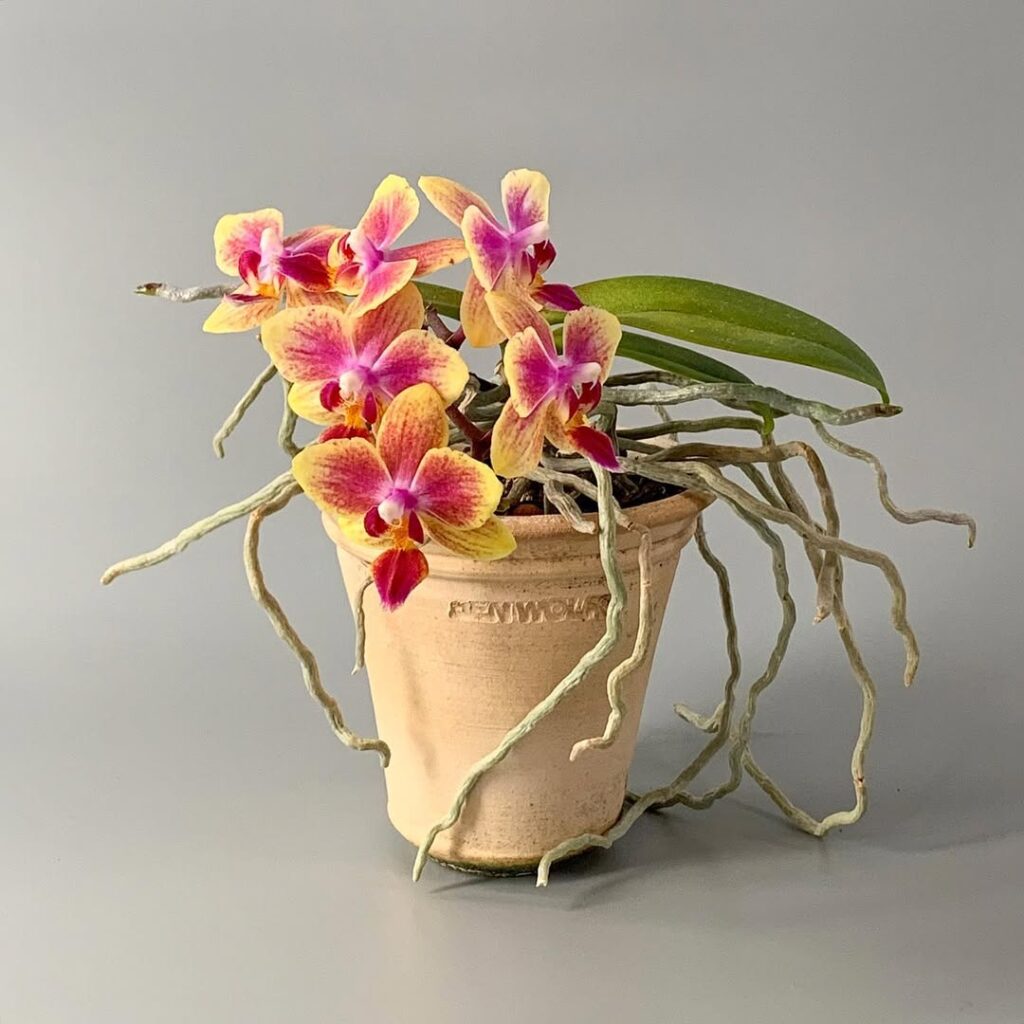
The Butterfly Orchid (Doritaenopsis) is a striking hybrid orchid variety known for its vibrant blooms and graceful butterfly-like appearance. These elegant orchids typically produce multiple flower spikes with numerous blossoms that can last several months when properly cared for. The flowers range from deep royal purple to lighter lavender shades, often featuring white or yellow accents in the center. Their leaves are thick and leathery, growing in a fan-like arrangement that adds to their ornamental appeal even when not in bloom.
- Light: Bright, indirect sunlight; avoid direct sun exposure; east or north-facing windows are ideal
- Water: Allow soil to dry slightly between waterings; water thoroughly when top inch of media feels dry
- Humidity: 50-70% humidity; use humidity trays or room humidifiers if needed
- Temperature: 65-80°F (18-27°C) during day, with a 10-15°F drop at night
- Soil: Well-draining orchid mix containing bark, sphagnum moss, and perlite
- Fertilizer: Balanced orchid fertilizer at quarter strength every other watering during growing season
- Repotting: Every 1-2 years when media breaks down or roots outgrow pot
13. Spider Plant
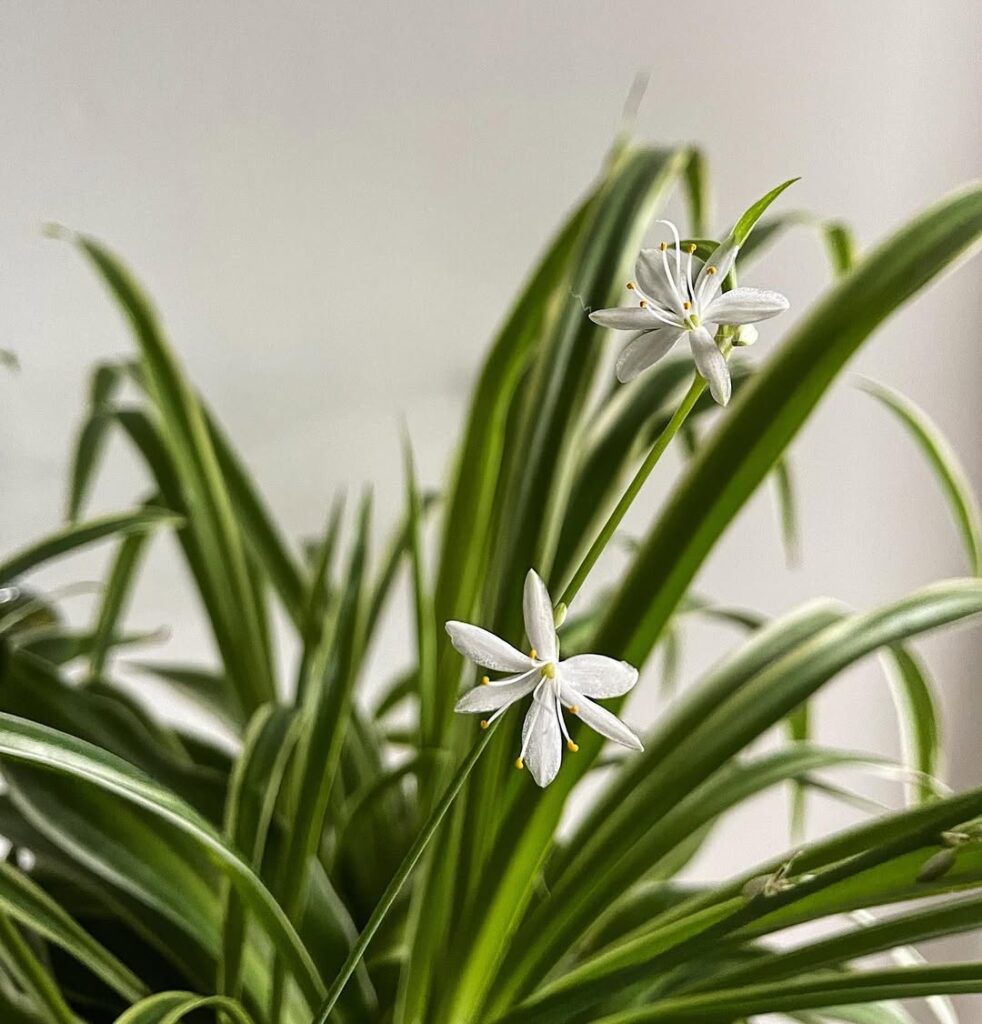
The Spider Plant (Chlorophytum comosum) is not primarily known for its flowers, but it does produce small, star-shaped white blooms on long stems when mature and given proper care. These delicate flowers appear intermittently throughout the growing season, though the plant’s main appeal lies in its arching, grass-like foliage with distinctive stripes and the production of baby plantlets that dangle from long stems. While the flowers are subtle, they add an extra decorative element to this already attractive houseplant.
- Light: Bright, indirect sunlight; can tolerate lower light conditions but may not flower; avoid direct sun which can scorch leaves
- Water: Keep soil moderately moist; allow top inch to dry between waterings; reduce watering in winter
- Soil: Well-draining potting mix rich in organic matter
- Humidity: Tolerates average household humidity; benefits from occasional misting
- Temperature: Thrives in 60-75°F (15-24°C)
- Fertilizer: Feed with balanced liquid fertilizer every 2-4 weeks during growing season
- Container: Use pot with drainage holes; repot when rootbound
- pH Level: Slightly acidic to neutral (6.0-7.2)
14. Miniature Roses
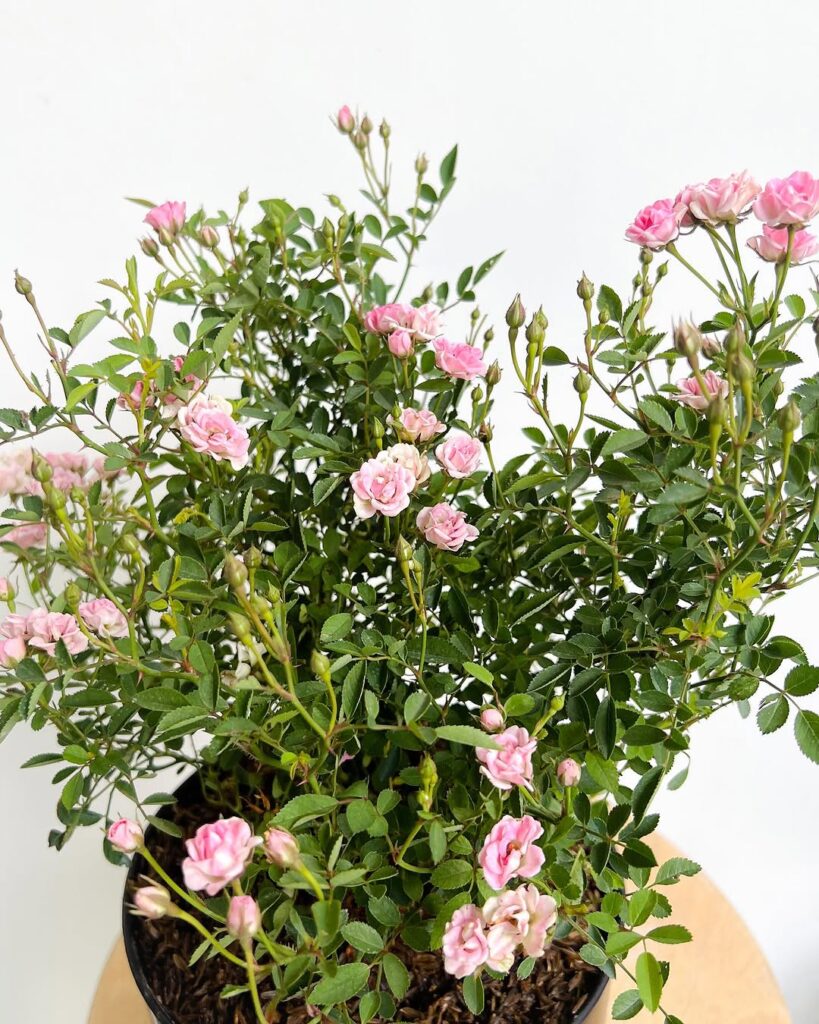
The Miniature Rose is a compact indoor rose variety that typically grows between 6-12 inches tall, making it perfect for windowsills and small spaces. These petite roses produce clusters of blooms throughout the year when properly maintained, featuring the same classic rose fragrance as their larger outdoor counterparts but in a scaled-down size. While they can be challenging to keep healthy indoors, their continuous blooming habit and charming appearance make them a rewarding choice for indoor gardeners.
- Light: Bright, direct sunlight for at least 6 hours daily; place near south-facing windows
- Water: Keep soil consistently moist but not waterlogged; water when top inch of soil feels dry
- Soil: Well-draining, slightly acidic potting mix rich in organic matter
- Temperature: 65-75°F during day, slightly cooler at night
- Humidity: Moderate to high; mist leaves regularly or use humidity tray
- Fertilizer: Feed every 2 weeks with balanced liquid fertilizer during growing season
- Pruning: Remove spent blooms and trim regularly to maintain shape
- Container: Use pot with drainage holes; repot every 2-3 years
15. Cyclamen
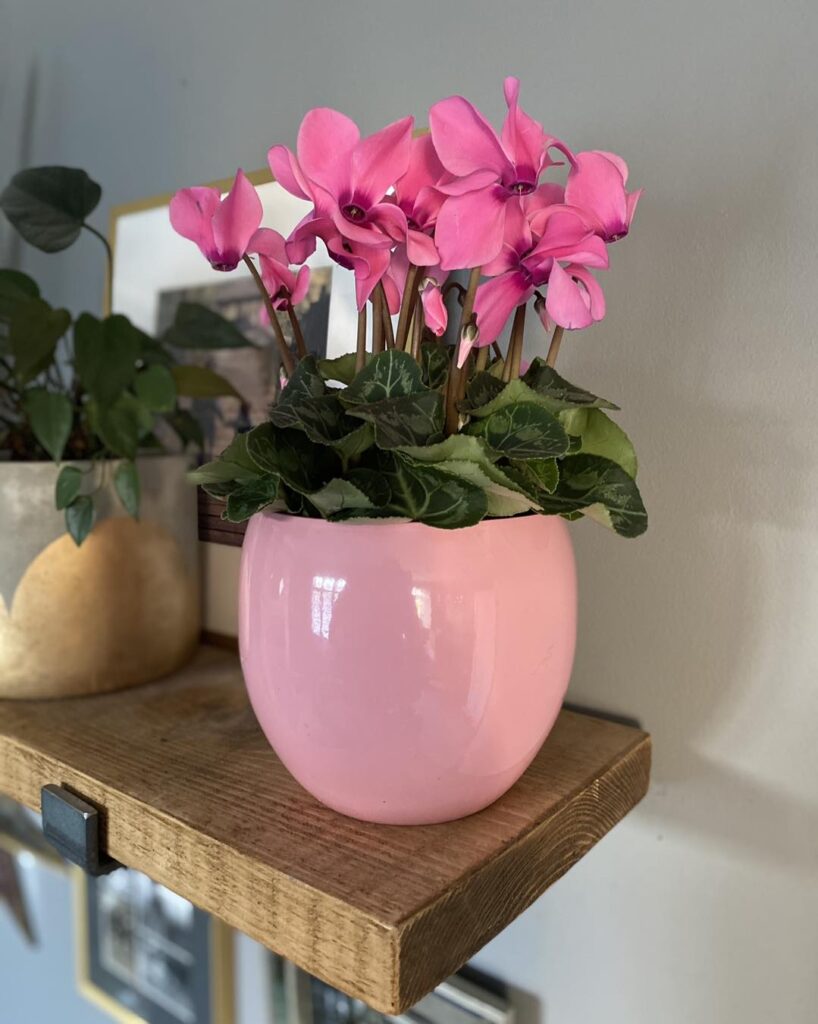
The Cyclamen plant produces delicate, butterfly-like flowers in shades of pink, purple, red, and white, blooming above heart-shaped, silver-marbled leaves. As a popular indoor plant, cyclamen typically flowers from late fall through early spring, entering a dormant period during summer months. The plant grows from a tuberous root system and can live for many years when properly cared for, making it an excellent long-term houseplant choice.
- Light: Bright, indirect light; avoid direct sunlight which can damage leaves
- Temperature: Cool conditions between 60-65°F (15-18°C)
- Water: Keep soil slightly moist but never waterlogged; water from bottom to avoid tuber rot
- Soil: Well-draining, slightly acidic potting mix rich in organic matter
- Humidity: Moderate to high humidity; use pebble tray or mist regularly
- Fertilizer: Feed monthly with balanced, water-soluble fertilizer during growing season
- Dormancy: Reduce watering when leaves yellow and allow plant to rest during summer months
